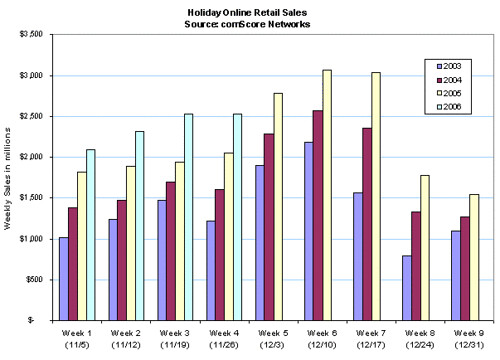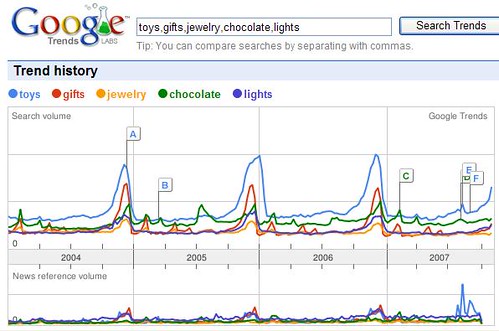Forget Black Friday! Are You Ready For Holiday Season’s Cyber Mondays?
“Black Friday,” the day after Thanksgiving, is the biggest shopping day of the year for U.S. brick-and-mortar retailers. But, for each Monday after Black Friday, consumer searches spike up on the internet and online retail websites enjoy their highest traffic and associated sales of the year. Search engine use is directly impacting businesses during this […]
“Black Friday,” the day after Thanksgiving, is the biggest shopping day of the year for U.S. brick-and-mortar retailers. But, for each Monday after Black Friday, consumer searches spike up on the internet and online retail websites enjoy their highest traffic and associated sales of the year. Search engine use is directly impacting businesses during this period, and companies which haven’t optimized their internet presence stand to lose out on some of the sales they could be getting if consumers could find them. This is true for online businesses as well as for brick-and-mortar stores.
While savvy companies planned for this season all the way back in the summer, and already have their internet storefronts in order, it’s not too late to do a few more things to insure a business can squeeze out more from gift shoppers on the “Cyber Mondays” following Black Friday.
The first Monday after Thanksgiving is called “Cyber Monday,” although we really should say “Cyber Mondays”—plural—since there are multiple high-traffic Mondays ramping upward and peaking out somewhere around the middle of December.
Source: DoubleClick Performics Chief Marketer blog: holiday peak day planning
Source: comScore Press Release: Cyber Monday E-Commerce Spending Beats Forecast
Although the term “Cyber Monday” was coined just a couple of years back as a conceit to help promote online sales for etailers by creating “buzz” similar to that of Black Friday, the term does describe a very real seasonal trend caused by internet users who are purchasing gifts online or who are looking for offline shops where they’ll buy presents and holiday supplies. For many sites, Mondays have the highest internet usage every week, and this normal trend line becomes even more exaggerated and increased as shoppers flock to find product information, locate stores, or buy online.
Keyword searches for holiday-related subjects traditionally start increasing sharply during the last quarter of every year, maxing out just before Christmas:
Source: Google Trends
It’s thought that the first Monday after Thanksgiving is when this really kicks into high gear, as people return to work from the holidays and squeeze in a moment or two at their office computers trying to find gifts. This year, according to a BIGresearch survey conducted for Shop.org, 54.5 percent of office workers with Internet access, or 68.5 million people will shop for holiday gifts from work, up substantially from 50.7 percent in 2006 and 44.7 percent in 2005. Forrester Research is predicting a 21% increase in online retail sales this year, compared with last.
The internet impact on shopping continues to increase, and changes in search engines’ formatting and layouts of their search results will likely divert users from their initial intentions by some degree. Users searching for products to buy online could easily end up opting to go to a physical store location near them out of concern that they might not receive shipped gifts in time. And, users performing various local searches to find store locations could get lured by contextual advertising into ultimately buying gifts online due to the convenience and free shipping offered by many etailers.
So, if you’re a business that needs holiday shopping to make your year a success, there are two major things you need to enable.
Brick-and-mortar stores need to be optimal for local search—your website should have easy-to-find street address, online map, and phone numbers for each of your locations. You should also be easily found in local search engines and online yellow pages directories.
Online retailers (“e-tailers”) should be findable when consumers use search engines to perform keyword searches for products and types of items that they wish to buy.
Since it can take some time to optimize a site for natural search traffic, and additional time for the search engine bots to index the changes and rank them properly for users to find, even if you did perform some optimization development on your site right now, chances are good that any changes would likely not have sufficient time to help you for this shopping season. But, there’s still a few ways to improve if you haven’t already done so.
Last-minute online optimization tips for local store sites and etailers:
- Brick-and-mortar stores should check their listing information in online yellow pages sites and local search engines. Fix anything that’s incorrect, and those changes have a very good chance of going live within a day or two.
- Brick-and-mortar stores should especially check to see that the Categories they’re listed under are correct. You’d be amazed at how often this is wrong, and how much more business you can get if users find your listing in the categories that are appropriate for them.
- If you’re not on the first page of results for your categories in online yellow pages and local search engines, you might think about advertising right now to get there. Bumping up your prominence will get you noticed more and will result in more conversions.
- For all types of sites, if you’re not already doing Pay-Per-Click advertising, consider buying a few good ads now in major search engines, in online yellow pages, and in other places across the internet where you believe your customers might likely hang out and find you. Afraid it might be too complex to manage hundreds or thousands of keyword ad campaigns if you have many products? Just set up one or two campaigns—it might be worthwhile in traffic for you; some traffic is better than none. Set up ads based on particular product names, product types, your type of store, and ads promoting your offline store locations. Ex: “candy stores in Boston, ma.”
- For e-tailers, consider uploading your products to Google Base so your product pages can get more referral traffic. Google Base feeds into Google Products, and Google Products listings can now appear for some searches, blended into the regular web search results pages (this “blended” format keyword search results page was introduced by Google earlier this year, and it’s called “Universal Search”). Overwhelmed at the thought of developing a database extraction and formatting it correctly? You could perhaps even just upload a very few products and it wouldn’t be a great burden.
- Join the crowd and issue a press release or two, related to the season. Talk about what’s selling hot, or funny things that happened in one of your stores, or what’s ultra-cool to buy this season. Make sure the online press release includes good keywords and links back to your website. A little humor or human interest aspect is particularly effective, too!
- List some of your prime products on eBay, and make sure your product description on there is linked back to your website, too, with a little text like “More items like this at ____” or “Find us online at ___”. Also make sure your item name is very accurate and includes the keywords that most users might use to find you, including a generic kind of name for the product. For example, “GPS Navigation System: Electronics Gifts for Dad.” I know eBay is a bit high on the time it takes to set up a listing and might not seem scalable to you in terms of the hassles of shipping. Think of this as another advertisement, though. You might be surprised how many people will get referred over to your website from a good eBay listing—this is a type of advertisement for you.
- Contact some of your local charities and offer to donate some amount of money for each sale of a certain product of yours if the purchaser shows you a copy of an email note or newsletter printed from the charity website outlining the offer. This can leverage the power of a charity to do promotion on your behalf by emailing their membership, and it also helps benefit a good cause!
- Make sure you’ve prominently promoted a discount of something you carry on your website! Forrester Research says that free shipping will figure heavily for online sales, and that gift cards will be a big winner this year.
Finally, if you’re reading this and need to do some gift shopping yourself, you might try visiting Shop.org’s website, Cyber Monday, which is a nice guide of loads of top online merchants. Cyber Monday’s set up as an affiliate of these etailers, and percentages of all purchases through this shopping portal go to support the Ray M. Greenly Scholarship Fund, which provides scholarships for students interested in an eCommerce career.
We’re told that more than 500 retailers will be posting holiday promotions and special savings both on Cyber Monday and throughout the holiday season, so you might even find some good deals through there. On Cyber Monday itself, more than 400 special offers will be available on the site, some of which will be exclusive promotions only available on CyberMonday.com. Offers will include free shipping specials, doorbuster deals, percentages off, and free gifts with purchase.
May your eHoliday season be very warm and merry!
Chris “Silver” Smith is Lead Strategist at Netconcepts and writes for the Locals Only column which appears on Mondays at Search Engine Land.
Contributing authors are invited to create content for Search Engine Land and are chosen for their expertise and contribution to the search community. Our contributors work under the oversight of the editorial staff and contributions are checked for quality and relevance to our readers. The opinions they express are their own.
Related stories
New on Search Engine Land



